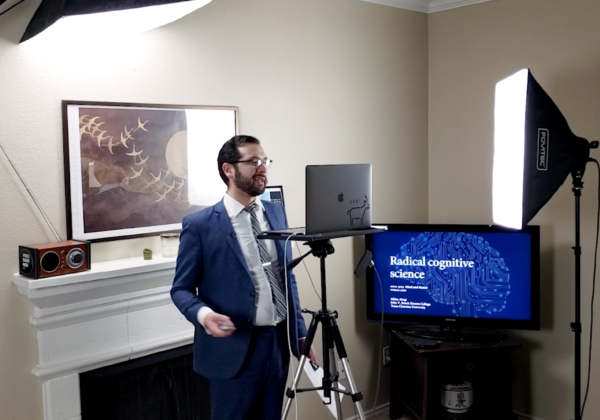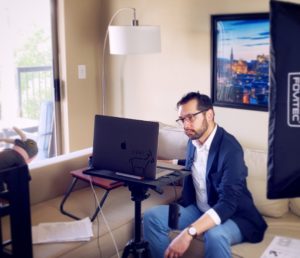
When TCU was forced to pivot to online courses because of the global coronavirus pandemic, Dr. Mikio Akagi, assistant professor of the history and philosophy of science, decided to set up a makeshift studio in his living room – equipped with a tripod, tripod mounts for his phone and computer, a lavalier microphone, wireless earbuds and three soft box lights.
In addition to hosting Zoom calls, Akagi used his home studio to record and produce lecture videos for his students, noting that he would often work late into the night editing videos. He produced two full lecture videos per week (one per class), which students would watch at the beginning of the week. He would then meet with his class virtually to discuss the video topics during their second meeting of the week.

His work with video in the spring inspired him to compile a technical guide of tips and tricks for teaching remotely that he shares on his website.
One of his biggest takeaways? Audio is most important. “People will tolerate bad video but not bad audio,” he notes. He stresses that an external mic – even a simple $20 lavalier mic – can make all the difference.
As he prepares for another foray into remote teaching in the fall, he admits that he’ll probably cut back a bit on his video work, opting for shorter clips that serve as supplementary material for his courses in lieu of full lectures. However, he still plans to continue using his new technical tools to provide students with an enhanced virtual experience.
In addition to spending less time editing videos, he jokes that it’ll be nice to have his living room back. “The soft box lights were not easy to set up, so they just sat as a looming presence in my living room for weeks. I was very excited to take them down at the end of the semester,” he said.
Though he has enjoyed taking the time to learn – and share – new technical tips and tricks involving video in the classroom, he admits that his experience during the pandemic has given him enhanced perspective on in-person interaction.
“I really do appreciate what you can do in person,” he said. “When it’s safe, I will be very happy to move back into the classroom.”